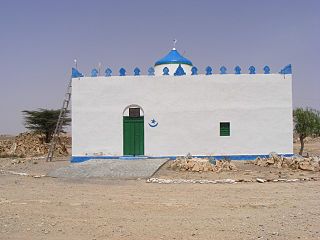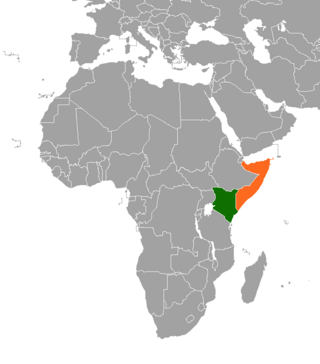
Somalia is a country located in the Horn of Africa which officially consists of the intra-46th meridian east territory, the seven federal member states, namely Galmudug, Hirshabelle, Jubaland, South West, Puntland, and the municipality of Benadir. It is bordered by Ethiopia to the west, the Gulf of Aden to the north, the Somali Sea and Guardafui Channel to the east, and Kenya to the southwest. With a land area of 637,657 square kilometers, Somalia's terrain consists mainly of plateaus, plains and highlands. Its coastline is more than 3,333 kilometers in length, the longest of mainland Africa. It has been described as being roughly shaped "like a tilted number seven".

Ogaden is one of the historical names used for the modern Somali Region. It is also natively referred to as Soomaali Galbeed. The region forms the eastern portion of Ethiopia and borders Somalia. It also includes another region to the north known as Haud.

Greater Somalia sometimes also called Greater Somaliland is the geographic location comprising the regions in the Horn of Africa in which ethnic Somalis live and have historically inhabited.

The North Eastern Province is one of the former provinces of Kenya. It had a land area of 127,358.5 km2, with its capital at Garissa. The North Eastern Province was carved out of the then Northern Frontier District (NFD) prior to independence.

The Ajuran is a Somali clan, part of the Jambelle clan which itself belongs to the largest Somali clan-family — the Hawiye. Ajuran members largely inhabit Kenya as well as southern east Ethiopia; considerable numbers are also found in southern Somalia. Some Ajuran members are settled in Mogadishu.

The Darod is a Somali clan. The forefather of this clan is Sheikh Abdirahman bin Isma'il al-Jabarti, more commonly known as Darod. The clan primarily settles the apex of the Horn of Africa and its peripheries, the Somali hinterlands adjacent to Oromia (Ogaden), and both sides of the Kenya–Somalia border. The Darod clan is the largest Somali clan family in the Horn of Africa.

The Garre are a prominent Somali clan that traces its lineage back to Samaale, who is believed to have originated from the Arabian Peninsula through Aqiil Abu Talib. The Garre clan is considered to be a sub-clan of the Digil-Rahanweyn clan family, which is part of the larger Rahanweyn clan. However, genealogically, they are descended from Gardheere Samaale. The Garre are also categorized as southern Hawiye as well.

The Ogaden is one of the major Somali clans in the Horn of Africa.

The Orma is one of the Oromo clans in the Horn of Africa, who predominantly live in Tana River County in northern Kenya and in southern Ethiopia. They share a common language and cultural heritage with other Oromo clans. They are pastoralists and almost all are Muslims. In 2019 the Orma numbered 158,993.

The Haud, formerly known as the Hawd Reserve Area, is a plateau situated in the Horn of Africa consisting of thorn-bush and grasslands. The region includes the northern part ofthe Somali Republic as well as the northern and eastern parts of the Somali Region of Ethiopia. Haud is a historic region as well as an important grazing area and has multiple times been referenced in countless notorious poems. The region is also known for its red soil, caused by the soil's iron richness. The Haud covers an estimated area of about 119,000 square km, more than nine-tenths the size of England, or roughly the size of North Korea.

The Somali Patriotic Movement was a major politico-military faction during the early years of the Somali Civil War. It was founded and commanded by Colonel Bashir Bililiqo, After his death in 1992, he was succeeded by Major General Aden Abdullahi Nur and his deputy Major General Mohammed Said Hersi Morgan the group was based in what is presently Jubaland region.
The Somali Rebellion was the start of the Somali Civil War that began in the 1970s and resulted in the collapse of the Somali Democratic Republic in 1991. The rebellion effectively began in 1978 following a failed coup d’état and President Siad Barre began using his special forces, the "Red Berets", to attack clan-based dissident groups opposed to his regime. Backed by Ethiopia, the two earliest rebel factions, the Somali Salvation Democratic Front (SSDF) and the Somali National Movement (SNM) began attacks during the against government forces during the early 1980s.
Over the course of the Somali Civil War, there have been many revolutionary movements and militia groups run by competing rebel leaders which have held de facto control over vast areas within Somalia.
The Shifta War or Gaf Daba (1963–1967) was a secessionist conflict in which ethnic Somalis in the Northern Frontier District (NFD) of Kenya attempted to join Somalia. The Kenyan government named the conflict "shifta", after the Swahili word for "bandit", as part of a propaganda effort. The Kenyan counter-insurgency General Service Units forced civilians into "protected villages" as well as killing livestock kept by the pastoralist Somalis.

Aden Abdullahi Nur "Gabyow". was a very senior Somali, Military Officer, Faction Leader, Politician, a leading member and one of the most powerful men in the Somali Democratic Republic.

The Somali–Kenyan conflict has been an issue within Kenya since the colonial period. Problems have ranged from skirmishes between the two communities and have led to terrorist attacks, police harassment, extortion, home invasions, physical violence, and massacres perpetrated against Somalis and Kenyans.

Jubaland, or the Juba Valley, is a Federal Member State in southern Somalia. Jubba River, stretching from Dolow to the Indian Ocean, while its western side flanks the North Eastern Province in Kenya, which was carved out of Jubaland during the colonial period.

Somali nationality law is regulated by the Constitution of Somalia, as amended; the Somali Citizenship Law, and its revisions; and various international agreements to which the country is a signatory. These laws determine who is, or is eligible to be, a national of Somalia. The legal means to acquire nationality, formal legal membership in a nation, differ from the domestic relationship of rights and obligations between a national and the nation, known as citizenship. Nationality describes the relationship of an individual to the nation under international law, whereas citizenship is the domestic relationship of an individual and the state. Somali nationality is typically obtained under the principle of jus soli, i.e. by birth in Somalia, or jus sanguinis, born to parents with Somali nationality. It can be granted to persons with an affiliation to the country, or to a permanent resident who has lived in the country for a given period of time through grant (naturalization).

Somalis in Ethiopia refers to the ethnic Somalis from Ethiopia, particularly the Ogaden, officially known as the Somali Region. Their language is primarily Somali and are predominantly Muslim. According to the 2007 census from the Central Statistical Authority, the Somalis were the third largest ethnic group in Ethiopia with roughly 4.6 million people accounting for 8.2% of the country's population, after Oromo (34.4%) and Amhara (27%). The Somali population in Ethiopia make up around 30% of the total Somali population worldwide.

The Ethiopia–Somalia border stretches 1,500 kilometers. In the 19th century, both Britain and Italy contributed to shaping the modern border, on behalf of their colonies of British and Italian Somaliland. The Somali people were thus under British, French, Italian and Ethiopian rule. During World War II, Britain gained control of the Ogaden and Haud territories and returned them to Ethiopia in 1954, but not delimited beyond the provisional line. Since 1960 independence, the border has suffered serious skirmishes involving both countries' soldiers. From 1977 to 1978, Ethiopia and Somalia fought in the Ogaden War led by Colonel Mengistu Haile Mariam and General Siad Barre respectively. The EPRDF government demarcated the border of Ogaden into Somali Region. Somalia is located at the base of Ethiopia's protrude southeast region; from the South, it is bounded by Wabi Shebelle and Genale Valley.















